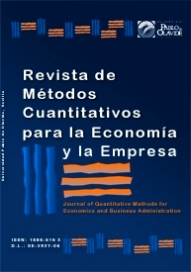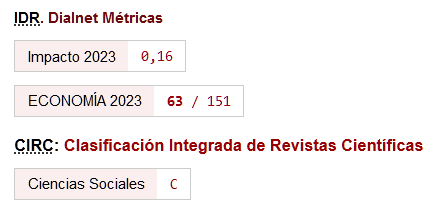House price dynamics in the wake of the Tax Cuts and Jobs Act of 2017
DOI:
https://doi.org/10.46661/rev.metodoscuant.econ.empresa.8487Keywords:
house price dynamics, tax cuts, event studyAbstract
The Tax Cuts and Jobs Act of 2017 (TCJA) changed tax policy in two important aspects. It limited state and local tax deductions (SALT) to $10,000 and lowered marginal tax rates in most income brackets. In this analysis, I estimate house price time series models for 20 U.S. cities using Case-Shiller data and test for series breaks when TCJA was adopted and implemented. The purpose is to test whether there is a unit root with breakpoints in each series. If so, the TCJA shock was permanent, not transitory, and the time series process is not mean reverting. Results reveal significant breaks in 12 of the 20 city indices. Additionally, there are significant breakpoints in 22 of the 48 tests across city price tiers (16 cities with three house price tiers each). The modal break date is the month of TCJA legislation passage with another 13 significant breakpoints within six months of TCJA adoption. Results indicate that TCJA was associated with an initial negative effect on house prices in many housing markets and price tiers. Importantly, the presence of unit root processes indicates that house price dynamics are more variable subsequently.
Downloads
References
Anderson, John E., Jeffrey Clemens, and Andrew Hanson. (2007). Capping the mortgage interest deduction. National Tax Journal, 60(4), 769-85.
https://doi.org/10.17310/ntj.2007.4.05
Bourassa, Steven C., Martin Hoesli, and Elias Oikarinen. (2019). Measuring house price bubbles. Real Estate Economics, 47(2), 534-563.
https://doi.org/10.1111/1540-6229.12154
Bourassa, Steven C., and William G. Grigsby. (2000). Income tax concessions for owner-occupied housing. Housing Policy Debate, 11(3), 521-46.
https://doi.org/10.1080/10511482.2000.9521377
Damen, Sven, Frank Vastmans, and Erik Buyst. (2014). The long-run relationship between house prices and income reexamined: The role of mortgage interest deduction and mortgage product innovation. KU Leven Discussion Paper No. 14.09.
https://doi.org/10.2139/ssrn.2429264
Dickey, David A. and Wayne A. Fuller. 1979. "Distribution of the estimators for autoregressive time series with a unit root." Journal of the American Statistical Association 74(366): 427-431.
https://doi.org/10.2307/2286348
Enders, Walter. (2004). Applied Econometric time series, Second edition. Hoboken, NJ: John Wiley & Sons Inc.
Escobari, Diego, Danian Damianov and Andres Bello. (2012). A time series test to identify housing bubbles. Munich Personal RePEc Archive, MPRA Paper No. 44360: http://mpra.ub.uni-muenchen.de/44360/
Eviews. (2019). Unit root tests with a breakpoint. http://www.eviews.com/help/helpintro.html#page/content/advtimeser-Unit_Root_Tests_with_a_Breakpoint.html
Glaeser, E.J., J. Gyourko, and R. Saks. (2005). Why have housing prices gone up? American Economic Review, 95(2), 329-333.
https://doi.org/10.1257/000282805774669961
Glynn, John, Nelson Perera, and Reetu Verma. (2007). Unit root tests and structural breaks: A survey with applications. Journal of Quantitative Methods for Economics and Business Administration, 3(1), 63-79.
Green, Richard K., and Kerry D. Vandell. (1999). Giving households credit: How changes in the U.S. tax code could promote homeownership. Regional Science and Urban Economics, 29(4), 419-44.
https://doi.org/10.1016/S0166-0462(99)00005-8
Haldrup, Niels, Robinson Kruse, Timo Terasvirta, and Rasmus T. Varneskov. (2012). Unit roots, nonlinearities and structural breaks. CREATES Research Paper 2012-14. Department of Economics and Business, Aarhus University, Denmark.
https://doi.org/10.4337/9780857931023.00009
Herranz, Edward. (2017). "Unit root tests." Wiley Interdisciplinary Reviews: Computational Statistics. Available at: Unit root tests - Herranz - 2017 - WIREs Computational Statistics - Wiley Online Library
https://doi.org/10.1002/wics.1396
Himmelberg, Charles, Christopher Mayer, and Todd Sinai. (2005). Assessing high house prices: Bubbles, fundamentals, and misperceptions. Journal of Economic Perspectives, 19(4), 67-92.
https://doi.org/10.1257/089533005775196769
Kim, Dukpa, and Pierre Perron. (2009). Unit root tests allowing for a break in the trend function at an unknown time under both the null and alternative hypotheses. Journal of Econometrics, 148, 1-13.
https://doi.org/10.1016/j.jeconom.2008.08.019
Lai, Rose Neng, and Robert Van Order. (2017). U.S. house prices over the last 30 years: Bubbles, regime shifts and market (in)efficiency. Real Estate Economics, 45(2), 259-300.
https://doi.org/10.1111/1540-6229.12127
Lucking, Liz. (2019). Tax reform exacerbates sales cooldown in the U.S. Wall Street Journal, April 11, 2019.
McClelland, Robert, Livia Mucciolo, and Safia Sayed. (2022). How did the tax cuts and jobs act of 2017 affect the housing market? Tax Policy Center, Washington, DC.
Phillips, Peter C.B., Yangru Wu, and Jun Yu. (2011). Explosive behavior in the 1990s NSSDAQ: When did exuberance escalate asset values? International Economic Review, 52(1), 201-226.
https://doi.org/10.1111/j.1468-2354.2010.00625.x
Poterba, James M. (1992). Taxation and housing: Old questions, new answers. American Economic Review, 82(2), 237-242.
Poterba, James M. (1984). Tax subsidies to owner-occupied housing: An asset market approach. Quarterly Journal of Economics, 99(4), 729-752.
https://doi.org/10.2307/1883123
Rosen, Harvey S. (1985). Housing subsidies: Effects on housing decisions, efficiency, and equity. In Handbook of Public Economics, Volume 1, edited by Martin Feldstein and Alan Auerbach, 375-420. Amsterdam: North-Holland.
https://doi.org/10.1016/S1573-4420(85)80010-0
Rosen, Harvey S. (1979a). Housing decisions and the U.S. income tax: An econometric analysis. Journal of Public Economics, 11(1), 1-23.
https://doi.org/10.1016/0047-2727(79)90042-2
Rosen, Harvey S. (1979b). Owner occupied housing and the federal income tax: Estimates and simulations. Journal of Urban Economics, 6(2), 247-66.
https://doi.org/10.1016/0094-1190(79)90008-1
Rosen, Harvey S., and Kenneth T. Rosen. (1980). Federal taxes and homeownership: Evidence from time series. Journal of Political Economy, 88(1), 59-75.
https://doi.org/10.1086/260847
Saunders, Laura. (2019). An answer to a SALT-y tax problem you didn't know you had. Wall Street Journal, March 22, 2019.
Sommer, Kamila and Sullivan, Paul. (2020). The effect of the tax cuts and jobs act on the housing market. July 22, 2020.
https://doi.org/10.2139/ssrn.3474116
Taipalus, K. (2006). A global house price bubble? Evaluation based on a new rent-price approach. Research Discussion Paper No. 29-2006. Bank of Finland.
https://doi.org/10.2139/ssrn.1018329
Theus, Brandon. (2022). Impacts of the tax cuts and jobs act of 2017 on real estate ownership and investment. Impacts of the Tax Cuts and Jobs Act of 2017 on Real Estate Ownership and Investment (americanbar.org)
Virtanen, Timo, Eero Tolo, Matti Viren, and Katja Taipalus. (2018). Can bubble theory foresee banking crises? Journal of Financial Stability, 36, 66-81.
https://doi.org/10.1016/j.jfs.2018.02.008
Vogelsang, Timothy J. and Pierre Perron. (1998). Additional tests for a unit root allowing for a break in the trend function at an unknown time. International Economic Review 39 (4): 1073-1100.
https://doi.org/10.2307/2527353
Yiu, Matthew S., Jun Yu, and Lu Jin. (2013). Detecting bubbles in hong kong residential property market. Journal of Asian Economics, 28, 115-1254.
https://doi.org/10.1016/j.asieco.2013.04.005
Zhang, Jing. (2014). Three essays on house prices: Stationarity, dynamics, and expectations. Dissertation presented in partial fulfillment of the requirements for the degree Doctor of Philosophy in the graduate school of The Ohio State University. https://etd.ohiolink.edu/!etd.send_file?accession=osu1397436206&disposition=inline
Downloads
Published
How to Cite
Issue
Section
License
Copyright (c) 2024 John Anderson

This work is licensed under a Creative Commons Attribution-ShareAlike 4.0 International License.
Submission of manuscripts implies that the work described has not been published before (except in the form of an abstract or as part of thesis), that it is not under consideration for publication elsewhere and that, in case of acceptance, the authors agree to automatic transfer of the copyright to the Journal for its publication and dissemination. Authors retain the authors' right to use and share the article according to a personal or instutional use or scholarly sharing purposes; in addition, they retain patent, trademark and other intellectual property rights (including research data).
All the articles are published in the Journal under the Creative Commons license CC-BY-SA (Attribution-ShareAlike). It is allowed a commercial use of the work (always including the author attribution) and other derivative works, which must be released under the same license as the original work.
Up to Volume 21, this Journal has been licensing the articles under the Creative Commons license CC-BY-SA 3.0 ES. Starting from Volume 22, the Creative Commons license CC-BY-SA 4.0 is used.










